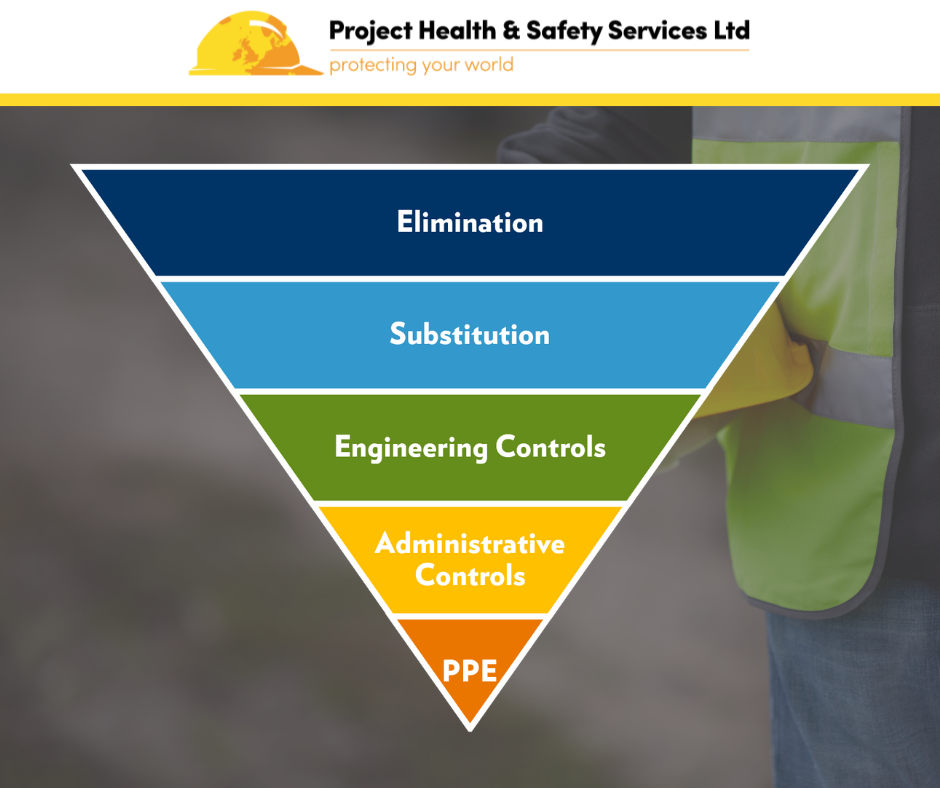In the high-risk environment of construction sites, ensuring safety is essential. But where do we start? How do we prioritise safety measures effectively? Enter the Hierarchy of Controls – a systematic approach to risk management, based on the HSE’s principles of prevention, that guides us in selecting the most effective safety measures. Implementing these controls in the correct order, ensures that hazards are addressed at their source, maximising safety in the workplace. In this blog, we’ll explore each layer of the hierarchy and its application in the construction industry.

Elimination
At the top of the hierarchy sits elimination – the most effective method of hazard control. This involves completely removing the hazard from the workplace. By eliminating the hazard altogether, you remove the possibility of exposure, making it the most reliable way to ensure workplace safety.
In construction, one example might be eliminating the hazard of trailing cables and extension cords by installing additional power sockets strategically throughout the site, thereby eliminating the risk of trips and falls. However, its crucial to ensure that eliminating one hazard doesn’t introduce another, such as electrical hazards.
Substitution
Substitution is the next step in the hierarchy of controls, following elimination. While elimination involves removing the hazard altogether, substitution focuses on replacing the hazardous material, equipment, or process with a safer alternative. Substitution can be an effective method when complete elimination is not feasible or practical.
In construction, an example of substitution might involve replacing toxic chemicals with less hazardous alternatives for cleaning construction materials.
Engineering Controls
After elimination and substitution, the next step in the hierarchy of controls is engineering controls. Engineering controls are physical changes to the workplace or processes that are designed to remove or minimise the hazard at its source, thereby reducing the risk of exposure. Unlike elimination and substitution, which focus on removing or replacing the hazard, engineering controls aim to isolate workers from the hazard or create barriers to prevent exposure. Engineering controls are considered highly effective because they proactively address the hazard and provide long-term solutions.
In construction, examples of engineering controls include installing guardrails or barriers to prevent falls from heights, using automated equipment to reduce manual handling tasks, or implementing ventilation systems to remove airborne contaminants.
Administrative Controls
After engineering controls, the next step in the hierarchy of controls is administrative controls. While engineering controls focus on physical changes to the workplace, administrative controls involve implementing changes to work practices or procedures to reduce the risk of exposure to hazards. Administrative controls are often used when it’s not feasible to eliminate or substitute the hazard, or when engineering controls alone are insufficient to mitigate the risk. These controls aim to modify how tasks are performed, how workers interact with hazards, or how long they are exposed to hazards. While administrative controls are not as effective as engineering controls or elimination, they play a vital role in complementing other control measures and can help further reduce the risk of injury or illness.
In construction, examples of administrative controls include implementing training programs to educate workers on safe work practices, establishing work schedules to minimise exposure to hazardous conditions, or implementing signage and warning systems to alert workers to potential hazards.
Personal Protective Equipment (PPE)
The final step in the hierarchy of controls is the use of personal protective equipment (PPE). While elimination, substitution, engineering controls, and administrative controls focus on removing or minimising hazards at their source, PPE is the last line of defence and is used to protect workers from remaining hazards that cannot be adequately controlled by other means. While PPE is essential for protecting workers, it is considered the least effective control measure because it relies on the individual worker to use it correctly and consistently. Additionally, PPE does not eliminate the hazard but rather provides a barrier between the worker and the hazard. Therefore, it should only be used when other control measures are not feasible or while additional control measures are being implemented.
In construction, examples of PPE include wearing hard hats to protect against head injuries, using safety glasses to prevent eye injuries, or using respirators to protect against airborne contaminants.
In Conclusion…
Understanding the hierarchy of controls in construction safety is key for creating a safer work environment. By following this systematic approach, starting with elimination and progressing through substitution, engineering controls, administrative controls, and finally, personal protective equipment, construction companies can effectively mitigate hazards and protect the health and safety of their workers. Each level of the hierarchy plays a crucial role in minimising risks and preventing injuries and illnesses. By prioritising hazard control measures in this order, construction companies can build a culture of safety and ensure the well-being of their workforce.













